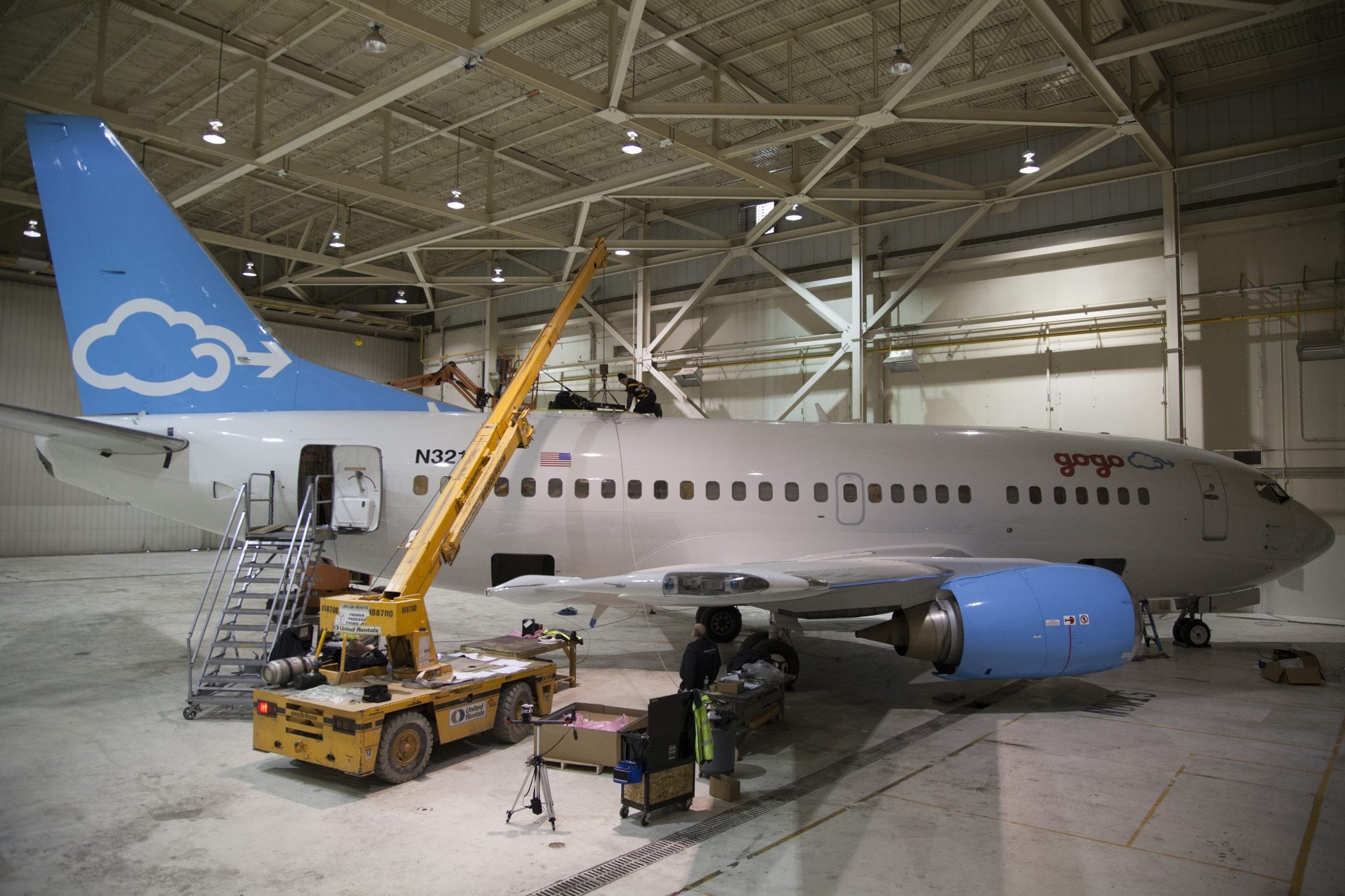[Avionics Today 02-25-2016] Gogo is citing its move to open architecture systems as a draw for airlines, including American Airlines, which is looking to jump to Gogo’s competitor ViaSat. CEO Michael Small emphasized the open architecture aspect of its 2Ku antenna technology during the In-Flight Connectivity (IFC) provider’s fourth quarter conference call on Feb. 23, which he says will offer airline customers more control over the systems and services they offer as in-flight Internet technology continues to evolve at a rapid pace.
 |
| Gogo installing the 2Ku satellite on its test plane. Photo: Gogo |
“Gogo is now operating with an open architecture,” Small said during the call. “[Open architecture] means greater assurance that the decision [airlines] make today won’t trap them in a technical box in the future.”
The company is emphasizing its technology amid a
recently dropped American Airlines’ lawsuit filed on Feb. 12, in which the airline alleged that the earlier generation Wi-Fi systems on board some 200 aircraft in American’s fleet were too limited and that better options existed for the carrier.
“Alternative service providers are offering faster, more reliable, and less expensive satellite-based Wi-Fi services to airlines like United, Southwest, JetBlue, and Virgin America,” American Airlines said in its suit.
While the airline has contracts with Gogo through 2018, it is contemplating dropping 200 of its aircraft equipped with 3G, Air-to-Ground (ATG) connectivity in favor of ViaSat, who has recently won a number of contracts — including a
major deal with Australia’s Qantas domestic fleet announced this week — for its satellite-based IFC service.
“American wants to explore its provider options for upgrading 200 of the more than 900 Gogo-equipped aircraft in its fleet. The move isn’t surprising given the rapidly changing technology in our industry,” Small said. “We’re competing for this piece of business. We will deliver a 2Ku proposal that gives American the option to get faster, cheaper, open-ended technology on board these aircraft,” Small said.
Small admits that, under the terms of the company’s contract with American, the decision to switch carriers is ultimately in the airline’s hands once Gogo submits a competing proposal. He argues, however, that the open systems approach to 2Ku tech will reduce upgrade costs for the airline’s fleet by cutting down on aircraft downtime and the costs of retrofitting for new technology in the future.
From a technological perspective, 2Ku was built on the redundancy of dozens of satellites currently in orbit but the CEO emphasizes that the system can also leverage the new Ku High Throughput Satellites (HTS) that have started going up and any of the new Ku-band, Low Earth Orbit (LEO) constellations coming online in the future.
“These satellite constellations will have tremendous advantages in terms of latency and coverage,” Small added, noting that the company was likely to release an announcement in this vein in the near future. “We’re not gambling on a single, closed system that ties us to a few satellites. Instead we are betting on an open architecture that will allow us to take advantage of whatever creative innovations the Google’s, the OneWeb’s, the SpaceX’s, the SES’, the Intelsat’s, and others will bring to the market,” said Small.
Gogo is expecting to equip 72 planes with Ku capacity this year, a number that Small says will quadruple in 2017. He also notes he has seen the cost of bandwidth drop by “two-thirds” since the company has initiated the open architecture project as investments in Ku satellites begin to materialize.
“The amount of investment in the Ku-band is dramatically larger than the amount of investment in the Ka-band. It’s not a technological issue as much as where the money is flowing and when we look at our choices for satellites we see hundreds of new satellites coming in the Ku band and we see a much scarcer offering in the Ka-band. That’s why we chose [Ku] and built an open architecture antenna,” he said.
To augment satellite connectivity, Gogo recently announced a
major deal with satellite provider SES for capacity aboard its SES 14 and SES 15 satellites that are set to launch in 2017, which will increase bandwidth for airline passengers connected with 2Ku traveling routes over North America, Central America and the Caribbean, according to the IFC provider. The deal, according to Small, is the largest dedicated aviation capacity deal ever struck. “It means we have capacity, and lots of it, using SES’ high throughput satellites,” he said, adding that this bump in capacity will translate to a drop in costs for airlines once the satellites come on line.
Small cites American’s decision to explore other options as inevitable as IFC becomes a larger, multi-player industry and cautions that the provider strive to keep up with the rapid pace of new tech in order to keep customers satisfied.
“American is absolutely right, our first-generation technology, which is still more than adequate for certain aircraft, is not cutting it today for some of their aircraft,” Small said. “But, in my view, American’s decision holds an even stronger message, single technology solutions are not only passé, they are risky … If connectivity technologies are not conceived and architected in a way that is open to new technologies, they won’t be good for long.”
The open architecture discussion came during the company’s fourth quarter conference call, in which it reported revenue for the full year 2015 at $500.9 million, up 23 percent over 2014. Operating costs also rose 23 percent throughout the year however, as the company strove to bring its 2Ku tech online.